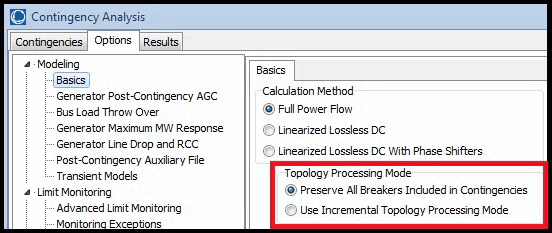Simulator Integrated Topology Processing allows solving contingencies in the Full-Topology Model.
EMS systems model contingencies through a list of real system actions. For instance, opening a line involves opening the set of breakers that electrically isolate the device. The same contingency action in a planning environment would be modeled as a single contingency action: OPEN LINE. Simulator provides a special contingency action called Open with Breakers which enables this type of modeling. There is also a Close with Breakers contingency action that enables modeling breakers to energize a device instead of using a planning-type contingency action to change the status of the device itself.
There is an option to determine whether to monitor all buses or only the primary node in each superbus during contingency analysis, When using Integrated Topology Processing, monitor only the primary bus for each superbus. This is found on the Contingency Analysis dialog on the Options tab on the Limit Monitoring page.
The option to determine how contingencies should be modeled within topology processing is found on the Contingency Analysis dialog on the Options tab and Modeling\Basics page in the Topology Processing Mode grouping.

Preserve All Breakers Included in Contingencies
If this option is selected, contingency analysis will not treat contingency breakers as zero impedance branches and will keep all of them in the model. Hence, the consolidated representation is obtained only once upfront before the first contingency, and this representation is used to solve all the contingencies. Using this option, the consolidated representation is smaller than the full model, but is not the smallest possible. If the number of contingencies and breaker actions is large, many breakers will be preserved in the case. If the percentage of preserved breakers is significant, this may result in an Ill-Conditioned Jacobian during the contingency solution.
Use Incremental Topology Processing Mode
In this option, contingency analysis uses an Incremental Topology Processing approach to solve each contingency. Since usually the number of contingency actions in a contingency is small (usually around 4 to 10), only a small number of Subnets are affected by a contingency. The topology of all the other subnets remains unchanged. When this option is used, Simulator does a full consolidation before the first contingency and then for each contingency, the topology of just the affected subnets is re-processed (determining superbuses and primary buses, and updating the connection pointers). Incremental Topology Processing provides a more robust solution and should be used whenever possible.
Incremental Topology Processing cannot be used for applications that use linearization and that require a constant size of the bus array, such as sensitivity analysis. For instance, ATC will automatically use the contingency analysis Preserve Breakers Included in Contingencies option.
NOTE: Consolidated branches flows (Breakers, Disconnects, ZBRs, etc.) are monitored during contingency analysis.